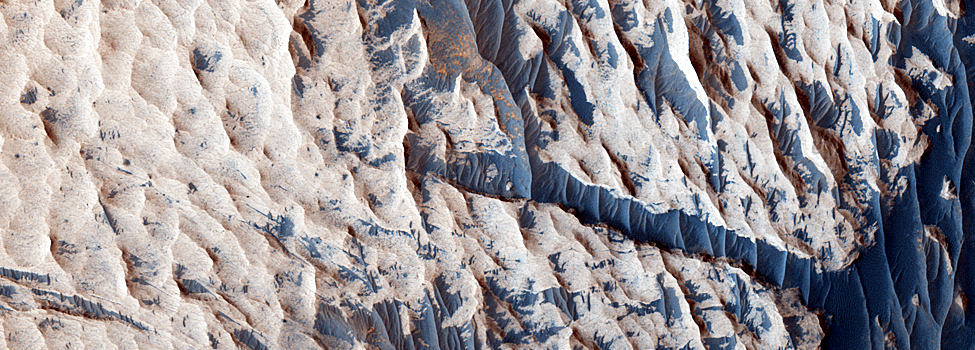Rocks & Regoliths Theme Description
Lead: Mike Mellon •
Images in this theme

A wide range of geologic processes operate on the surface of Mars today and throughout its history. Erosion by wind and water,
impacts, volcanism, and chemical weathering all act to break bedrock down into soils and dust. Wind and water are also effective
agents at sorting soil particles into deposits of distinct sizes. Sand dunes are an excellent example. The nature of these
soil surfaces tells us much of the history of the planet. From orbit we can attempt to map the distribution of soil types
and particle sizes though thermal mapping. Daily heating and cooling of the soil by the sun results in distinctly different
temperatures depending on the soil, much the same way beach sand becomes scalding in the sun and rocks retain heat at night.
However, some soils surfaces with different mixtures of rocks and sand can exhibit the same temperature characteristics.
Images of these surfaces can help separate soil types by observing rock distributions, slopes, and erosional patterns.
Major Science Questions for This Theme
What soil forming processes act on Mars over time? The nature of soils and the size of rocks tell us something of the history
of the soil surface and the nature of geologic processes that formed the soils. Are rocks primarily formed by impacts or
mass wasting? Both processes produce rocks in different ways and the rock size distribution will differ. How common are desert
pavements? Desert pavements are lag deposits of small rocks and pebbles that armor the soil against erosion.
They commonly occur on Earth in arid environments including Antarctic polar deserts. What locations on Mars exhibit cohesive
soils, indicating cementation? Cemented soils on Mars, called duricrust, have been observed at every landing site thus far,
but how globally common are duricrusts is yet unknown.
Relationship to Other Science Themes
The history of soils on Mars relates to many HiRISE science themes. Images of Mars are primarily images of a soil surface. While
this soil reflects much of the bedrock beneath, the soil itself is reworked, eroded, and deposited by a variety of geologic
processes. Aeolian transport moves sand and dust in the wind to redeposit them as dunes, sand sheets, and dust mantles.
Volcanic ash erupts onto the Martian surface forming loose or cemented deposits. Mass wasting can result in landslide deposits
of jumbled rocks, sand, and dust. Impacts generate large quantities of rocks and fine debris scattered in an ejecta blanket.
Features of Interest Potentially Visible at HiRISE Scale
Rocks on Mars come in a variety of sizes. However, rocks typically become more abundant as they reach smaller sizes due to
natural weathering processes - one large rock breaks into many small rocks. Large boulders the size of small cars and large
houses are commonly observed in Mars Global Surveyor images. Smaller rocks have yet to be observed except at landing sites.
HiRISE allows us to see rocks in a new size range and determine their distribution over the planet's surface. Determining the
size distribution of smaller rocks also provides clues about their formation.
